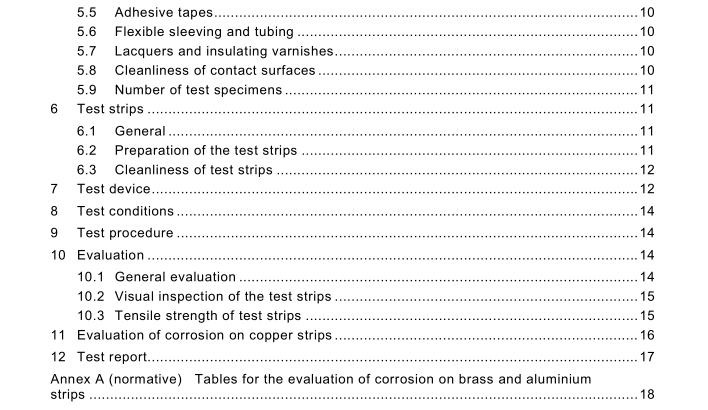IEC 60426:2007 pdf download – Electrical insulating materials – Determination of electrolytic corrosion caused by insulating materials – Test methods
5.2 Cut surfaces of rigid materials (blocks, plates, sheets or semi-finished materials)
The test specimens shall be cut out or machined from the tested material to a thickness of 4 mm, by means of a dry method without the use of cutting oils or lubricants and without overheating or damaging them. It is recommended to take several test specimens from various layers of the product. It is permissible to use the test specimens of thickness smaller than 4 mm, but not smaller than 2 mm. The contact surface of the test specimen shall be smoothed using abrasive paper. Care should be taken to keep parallelism of the opposite surfaces of the test specimen, in order to assure a good contact of the test specimen to the metal strips. The surface of contact should not show any flaws, cracks, inclusions or bubbles. The abrasive paper shall not contain any contaminations causing a bad corrosion index, for example halogen components.
5.3 Cast, moulding, injection and pressed materials From insulating materials delivered in the form of liquid resin, moulding powder or granules, the test specimens shall be made in shapes and dimensions as shown in Figure 1 . The specimens shall be made by casting or pressing in a special mould, following exactly the technological instruction recommended by the manufacturer of the tested material. The test specimen and surface of contact shall be prepared as given in 5.2.
5.4 Cut surfaces of flexible films, foils and thin sheets Test specimens of these products shall be made up in layers to form small packs placed between suitable holding plates of insulating material not causing electrolytic corrosion itself, for example polymethylmethacrylate (Plexiglas® 2 ). The preferred thickness of holding plates is 1 mm ± 0,2 mm. The thickness of a pack should be approximately of 4 mm or 2 mm, depending on the thickness of the tested foils. The value of 4 mm is recommended in the case of the single foil thickness being less than 2 mm and more than 0,5 mm, whereas that one of 2 mm is recommended if the single foil thickness is less than 0,5 mm. These test blocks shall be compressed with screws made of the same material as holding plates and then machined to the appropriate shape as shown in Figure 2. The material to be tested should protrude 0,2 mm to 0,5 mm beyond the holding plates.
Apart from this, the particulars given in 5.2 apply.
5.5 Adhesive tapes
For adhesive tapes the method of Clause 7 of IEC 60454-2 is recommended.
5.6 Flexible sleeving and tubing
Sleeving and tubing (both varnished fabric and extruded) are slit open, so as to make flat sheets, which can then be prepared as for films (see 5.4).
5.7 Lacquers and insulating varnishes
The lacquer or insulating varnish to be tested shall be applied in the manner recommended by the manufacturer to the surface of a test specimen of shape as shown in Figure 1 and described in 5.2. The base material of the test specimen shall be a corrosion free plastic such as polymethylmethacrylate. In case of solvent incompatibility or a baking temperature being too high for the base material, another suitable base material such as cast, hot cured corrosion free epoxy resin or glass shall be used. If the lacquer or insulating varnish is designed to contribute freedom from corrosion to another material, a test specimen of that material shall be used.
The tested lacquer or varnish shall be sprayed, dipped or otherwise coated to the desired thickness and baked, if necessary, as specified or according to the directions of the manufacturer. If the thickness of coating is not determined by specification or direction of the manufacturer, it shall be of (30 ± 1 0) μm.
5.8 Cleanliness of contact surfaces When preparing and handling the test specimens, any soiling of the test surfaces, for example by perspiration from the hands, shall be avoided. The specimens shall be touched only with a pair of tweezers or with protecting gloves made of materials free from corrosion (e.g. polyethylene). After the test specimens have been machined or cut, their surfaces shall be cleaned with a soft brush.
